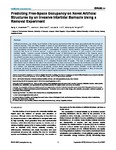Predicting Free-Space Occupancy on Novel Artificial Structures by an Invasive Intertidal Barnacle Using a Removal Experiment
| dc.contributor.author | Bracewell, SA | |
| dc.contributor.author | Robinson, LA | |
| dc.contributor.author | Firth, LB | |
| dc.contributor.author | Knights, AM | |
| dc.date.accessioned | 2015-07-01T14:48:41Z | |
| dc.date.available | 2015-07-01T14:48:41Z | |
| dc.date.issued | 2013 | |
| dc.identifier.issn | 1932-6203 | |
| dc.identifier.issn | 1932-6203 | |
| dc.identifier.other | ARTN e74457 | |
| dc.identifier.uri | http://hdl.handle.net/10026.1/3389 | |
| dc.description.abstract |
Artificial structures can create novel habitat in the marine environment that has been associated with the spread of invasive species. They are often located in areas of high disturbance and can vary significantly in the area of free space provided for settlement of marine organisms. Whilst correlation between the amount of free space available and recruitment success has been shown in populations of several marine benthic organisms, there has been relatively little focus on invasive species, a group with the potential to reproduce in vast numbers and colonise habitats rapidly. Invasion success following different scales of disturbance was examined in the invasive acorn barnacle, Austrominiusmodestus, on a unique art installation located in Liverpool Bay. Population growth and recruitment success were examined by comparing recruitment rates within disturbance clearings of 4 different sizes and by contrasting population development with early recruitment rates over a 10 week period. Disturbed areas were rapidly recolonised and monocultures of A. modestus formed within 6 weeks. The size of patch created during disturbance had no effect on the rate of recruitment, while a linear relationship between recruit density and patch size was observed. Density-dependent processes mediated initial high recruitment resulting in population stability after 8-10 weeks, but densities continued to greatly exceed those reported in natural habitats. Given that artificial structures are likely to continue to proliferate in light of climate change projections, free-space is likely to become more available more frequently in the future supporting the expansion of fast-colonising species. | |
| dc.format.extent | e74457-e74457 | |
| dc.format.medium | Electronic-eCollection | |
| dc.language | en | |
| dc.language.iso | eng | |
| dc.publisher | Public Library of Science (PLoS) | |
| dc.subject | Animals | |
| dc.subject | Climate Change | |
| dc.subject | Ecosystem | |
| dc.subject | Introduced Species | |
| dc.subject | Thoracica | |
| dc.subject | Time Factors | |
| dc.title | Predicting Free-Space Occupancy on Novel Artificial Structures by an Invasive Intertidal Barnacle Using a Removal Experiment | |
| dc.type | journal-article | |
| dc.type | Article | |
| plymouth.author-url | https://www.ncbi.nlm.nih.gov/pubmed/24023944 | |
| plymouth.issue | 9 | |
| plymouth.volume | 8 | |
| plymouth.publication-status | Published online | |
| plymouth.journal | PLoS ONE | |
| dc.identifier.doi | 10.1371/journal.pone.0074457 | |
| plymouth.organisational-group | /Plymouth | |
| plymouth.organisational-group | /Plymouth/Faculty of Science and Engineering | |
| plymouth.organisational-group | /Plymouth/Faculty of Science and Engineering/School of Biological and Marine Sciences | |
| plymouth.organisational-group | /Plymouth/REF 2021 Researchers by UoA | |
| plymouth.organisational-group | /Plymouth/REF 2021 Researchers by UoA/UoA07 Earth Systems and Environmental Sciences | |
| plymouth.organisational-group | /Plymouth/Users by role | |
| plymouth.organisational-group | /Plymouth/Users by role/Academics | |
| plymouth.organisational-group | /Plymouth/Users by role/Researchers in ResearchFish submission | |
| dc.publisher.place | United States | |
| dcterms.dateAccepted | 2013-07-31 | |
| dc.identifier.eissn | 1932-6203 | |
| dc.rights.embargoperiod | Not known | |
| rioxxterms.versionofrecord | 10.1371/journal.pone.0074457 | |
| rioxxterms.licenseref.uri | http://www.rioxx.net/licenses/all-rights-reserved | |
| rioxxterms.licenseref.startdate | 2013 | |
| rioxxterms.type | Journal Article/Review |


